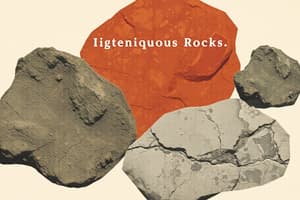Podcast
Questions and Answers
What is the characteristic of an igneous rock that has a fine-grained texture, with crystals that are very small and often not visible to the naked eye?
What is the characteristic of an igneous rock that has a fine-grained texture, with crystals that are very small and often not visible to the naked eye?
- Pegmatitic
- Porphyritic
- Phaneritic
- Aphanitic (correct)
What is the name of the process where magma cools and crystallizes to form rocks?
What is the name of the process where magma cools and crystallizes to form rocks?
- Magma formation
- Lava cooling
- Igneous rock formation
- Crystallization and solidification (correct)
Which of the following rocks is characterized by the presence of olivine and has a dark color?
Which of the following rocks is characterized by the presence of olivine and has a dark color?
- Dunite (correct)
- Obsidian
- Basalt
- Scoria
What is the term for rocks that have a high percentage of silica (more than 66%) and are typically light in color?
What is the term for rocks that have a high percentage of silica (more than 66%) and are typically light in color?
What is the term for the process of rapid cooling of lava on the surface of the Earth?
What is the term for the process of rapid cooling of lava on the surface of the Earth?
Which of the following rocks is characterized by the presence of quartz and k-feldspar and has a light color?
Which of the following rocks is characterized by the presence of quartz and k-feldspar and has a light color?
What is the term for rocks that have a glassy texture, with no crystals having formed?
What is the term for rocks that have a glassy texture, with no crystals having formed?
What is the term for rocks that have a coarse-grained texture, with crystals that are visible to the naked eye?
What is the term for rocks that have a coarse-grained texture, with crystals that are visible to the naked eye?
Which of the following rocks is characterized by the presence of pyroxene and Ca-rich plagioclase feldspar and has a dark color?
Which of the following rocks is characterized by the presence of pyroxene and Ca-rich plagioclase feldspar and has a dark color?
What is the term for rocks that have a high percentage of mafic minerals (less than 45% silica) and are typically dark in color?
What is the term for rocks that have a high percentage of mafic minerals (less than 45% silica) and are typically dark in color?
Flashcards
Aphanitic
Aphanitic
Igneous rocks with a fine-grained texture, where crystals are too small to be seen without a microscope.
Crystallization and solidification
Crystallization and solidification
The process of magma cooling and solidifying to form igneous rocks.
Dunite
Dunite
A dark-colored igneous rock rich in olivine.
Felsic
Felsic
Signup and view all the flashcards
Extrusive cooling
Extrusive cooling
Signup and view all the flashcards
Rhyolite
Rhyolite
Signup and view all the flashcards
Glassy
Glassy
Signup and view all the flashcards
Phaneritic
Phaneritic
Signup and view all the flashcards
Basalt
Basalt
Signup and view all the flashcards
Ultramafic
Ultramafic
Signup and view all the flashcards
Study Notes
Igneous Rock Identification
- Dunite: dark, phaneritic rock with dominant mineral olivine
- Basalite: dark, aphanitic rock with dominant minerals pyroxene and Ca-rich plagioclase feldspar
- Diorite: intermediate, phaneritic rock with dominant minerals amphibole and Na+Ca-plagioclase feldspar
- Granite: light, phaneritic rock with dominant minerals quartz and k-feldspar
- Obsidian: dark, glassy rock with dominant minerals olivine and Ca-rich plagioclase feldspar
- Rhyolite: light, aphanitic rock with dominant minerals quartz and k-feldspar
- Scoria: dark, vesicular rock with dominant minerals pyroxene and Ca-rich plagioclase feldspar
- Trachyite: intermediate, porphyritic rock with dominant minerals amphibole and Na+Ca-plagioclase feldspar
Igneous Rock Formation
- Igneous rocks form due to cooling and crystallization of magma
- Magma is molten rock in the Earth's interior
- Lava is similar to magma but forms at Earth's surface without gases
- Extrusive Igneous rocks form by rapid freezing of lava on the surface
- Intrusive Igneous rocks form by slow cooling of magma in the Earth's interior
Textures and Compositions
- Phaneritic: coarse-grained texture, crystals are visible to the naked eye
- Aphanitic: fine-grained texture, crystals are very small, often not visible to the naked eye
- Porphyritic: two or more crystal sizes visible in the same rock
- Pegmatitic: very large crystals (greater than 1/2 inch) are visible to the naked eye
- Glassy: no crystals have formed, rock breaks with a conchoidal fracture
- Pumaceous: extreme form of vesicularity
- Vesicular: rock has many gas bubble holes
- Felsic (acidic): rock has more than 66% silica, quartz is common, light color
- Intermediate: rock has 52-66% silica, amphibole is common, gray or gray-green color
- Mafic (basic): rock has 52-45% silica, olivine is common, dark or black color
- Ultra mafic: rock has less than 45% silica, olivine and pyroxene are common
Studying That Suits You
Use AI to generate personalized quizzes and flashcards to suit your learning preferences.




